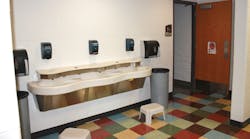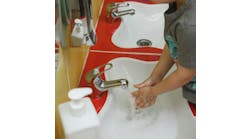Earlier this year, a high school in Pennsylvania was pushed into the media spotlight when it was reported that repeated acts of vandalism had prompted the principal to place restrictions on one of the boys’ bathrooms: The school had stopped stocking toilet paper in the stalls, and students who wanted to use that bathroom had to ask staff members in the principal’s or nurse’s offices for toilet paper.
The incident caught the public’s interest because of what some saw as the school’s punitive way of addressing student misconduct. Still, although many may disagree with the school’s response to the vandalism, most people who have spent time in school (i.e., everyone) can sympathize with a school administrator’s difficulty finding a solution to the neverending battle over bathroom behavior. Schools have to strike a balance between ensuring that student restrooms are safe environments and providing student with a suitable level of privacy.
Schools have tried various strategies at different times to address the problem. Some have limited when students can use the bathroom, and required students to sign out before being allowed to use the bathroom. Schools have been known to remove soap from bathrooms when students used it for mischief instead of cleaning up.
Others have removed the doors from toilet stalls so that students were deprived of the opportunity to craft graffiti in private. Some students have been conscripted into cleanup duty in school bathrooms when they’ve been found to be responsible for graffiti or other damage.
The issue of restroom safety has drawn more focus recently as educators and authorities have taken the issue of bullying more seriously. One recent survey found that 43 percent of students fear that they will be harassed in the bathrooms at their schools.
Not that many students actually endure bathroom bullying, but the problem is real. According to the National Center for Education Statistics Indicators of School Crime and Safety: 2012, 11 percent of students who reported being bullied at school in 2011 said the incident occurred in a bathroom or locker room.
Boys were more likely than girls to be bullied in bathrooms or locker rooms; 13.2 percent of boys bullied said the incident occurred in bathrooms or locker rooms; 9.2 percent of girls bullied identified the location as a bathroom or locker room. The statistics also show that bathroom bullying for students 12 to 18 is most common in seventh grade: 13.5 percent of students in that grade said they were bullied in a school bathroom; by 12th grade, only 9.3 percent of bullied students identified the location as a bathroom.
Safety steps
An assessment guide for school restrooms put together by the National Clearinghouse for Educational Facilities identifies characteristics that will help improve the safety and security of those spaces:
•School restrooms should be situated to maximize visual surveillance.
•Restrooms should be well-lighted and easy to supervise.
•Restrooms should be properly maintained, with no graffiti or offensive smells. “Well maintained restrooms promote orderly behavior by demonstrating respect for and ownership of property,” the guide says. “They draw legitimate users, boosting safety through their presence in larger numbers. Poorly maintained restrooms repel legitimate uses, including school staff, thereby reducing supervision.”
•Lighting fixtures should have vandalproof covers.
•Bathroom entry and exit doors should be ones that can be locked only from the outside and cannot be blocked easily from the inside.
•Toilet stall doors should be no more than 5 feet 6 inches tall and that have a 12-inch clearance above the floor to make surveillance easier.
•Sinks and hand dryers should be installed in publicly exposed areas to deter vandalism and encourage hand washing. Installing sinks in the corridor instead of inside the bathroom reduces the amount of time students are away from supervision and makes it less likely faucets and dispensers will be subject to abuse.
•Smoke detectors in washrooms should have vandal-resistant features such as protective cages or tamper alarms.
•Restrooms that are to be used by those in after-school activities should be situated so that they can be used without providing access to the rest of the school facility.
•Fixtures and hardware in washrooms should be made of vandal-resistant, readily cleanable materials. Partitions made of laminate or composite materials are considered resistant to graffiti.
•Bathrooms should have a hard ceiling that prevents students from hiding contraband in spaces above the ceiling.
•Windows in restrooms may not be desirable because they can serve as passageways for weapons, people or contraband.
•Washroom equipment such as dryers, vending machines and trash containers should be heavy-duty, recessed and fire-resistant. Locks should be in place to control access to trash containers.
•Consider a see-through design for equipment that holds paper towels, toilet paper and liquid soap so that the equipment can’t be used to hide contraband. For similar reasons, schools should remove unused holders from walls.
•Bathroom mirrors should be shatterproof.
•Group restrooms should have door-less maze entryways that enable adults outside the restroom to hear what is going on inside.
•A large-event washroom should have two means of entry and egress.
Bathroom design strategies that prevent the spread of germs also can deter users from damaging equipment. The fewer items that students need to touch in a washroom, the fewer opportunities they have to do some damage. Sensors enable students to flush urinals or toilets without coming into contact with handles.
Hands-free faucets, soap dispensers, paper towel dispensers or air dryers make it possible for students to use the facilities and practice good hygiene while minimizing the wear and tear—or abuse—of the equipment.
Sidebar: More welcoming
Efforts to make school restrooms safer seem to be paying off over the long term, if federal survey results are any indication.
The National Center for Education Statistics “Indicators of School Crime and Safety: 2012” found that compared with 16 years earlier, fewer students aged 12 to 18 characterized school bathrooms as places they avoided avoiding because of fear of attack or harm.
In 1995, the National Crime Victimization Survey found that 4.4 percent of students aged 12 to 18 avoided school restrooms. By 2011, the percentage of students avoiding washrooms had declined to 1.7 percent. That was an increase from the 2009 survey. That year, only 1.4 percent of students aged 12 to 18 reported that they avoided school bathrooms out of fear.
Kennedy is staff writer for AS&U.


